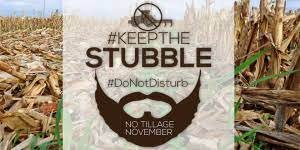Keep the Stubble on Your Fields
You may have noticed a lot more beards on friendly faces across Ashland County this month as folks forego shaving in an effort to increase cancer awareness during No-Shave November. But did you know there’s an even better place to keep the stubble this month? That’s right - it’s in your farm fields as we in the conservation and farming worlds celebrate No-Till November.
This month Ashland SWCD is encouraging our farmers to keep their tillage equipment in the shed and embrace a rugged, more natural look. No-till farming is one of the cornerstone practices to encourage soil health. Reduced tillage also improves water quality and is a key climate-smart practice that helps store carbon in the soil.
Those do-not-disturb signs are not just to hang on your hotel room door during vacation; they’re a great slogan to manage your farm by as well! Although many farmers still till their fields in the fall, there are many good reasons to leave those fields undisturbed.
You may have heard the benefits of no-till before: reduced erosion, saved time and fuel, improved nutrient cycling, soil moisture and resiliency in the face of drought. In fact, Ashland SWCD has been a long-time advocate of no-till and reduced till management. We even operate a no-till drill rental program to help area farmers take advantage of the benefits of no-till production.
According to the 2017 census of Agriculture, no-till practices were used on 37 percent of US farmland for which a tillage system was reported - up from 35 percent in 2012. That’s good news not only for farmers, but for everyone who benefits from clean, healthy watershways and healthy soil (hint: that’s you!). Not only was no-till use up, but reduced tillage increased to 35 percent in 2017 (a 12 percent increase since 2012), and intensive tillage use dropped to 28 percent (down from 28 percent in 2012).
Maintaining the “stubble” or ground cover on your farmland saves money on your bottom line. According to the USDA, farmers can expect to save about 3.6 gallons of fuel per acre when transitioning from conventional tillage to conventional no-till management.
Not only do no-till farmers save on fuel costs and wear and tear on their machinery and equipment, but perhaps most importantly, they also save their most valuable commodity: time.
No-till practices can improve soil health my leaving soil microbiology undisturbed. Beneficial soil microbes are essential for growing food, fiber and fuel. Plus, no-till improves the soil’s water holding capacity and helps keep soil (and nutrients) in their place and preventing harmful runoff and erosion. That additional residue or stubble can also provide wildlife habitat on your farm.
So are you ready to move from being no-till curious to a no-till manager? Then here are some tips to help you in your transition.
Evenly distributing your residue during harvest can help protect your soils from erosion by forming a protective barrier. Plus, even distribution allows for a more uniform breakdown of nutrients and organic matter.
Historically, tillage has been used to breakup soil and prepare seedbeds, but over time, tillage can degrade soil structure and lead to high levels of compaction that seem to “need” more tillage before planting—which contributes to the problematic cycle. Instead, consider placing a cover crop to reduce compaction, build organic matter, and prevent erosion.
If you’re already dealing with a highly compacted field, consider a deep rooted cover like tillage radishes or turnips to help break up that compaction naturally. And remember: each year Ashland SWCD partners with the Muskingum Watershed Conservancy District to offer a cover-crop cost share program that can help you feel more confident in taking the cover crop plunge.
You may also want to rethink your equipment needs. Next spring will you be planting into a green cover crop, a terminated cover or fall residue? Will you drill or broadcast your seeds? This goals and plans may change over time, but remember that Ashland SWCD is here to help.
Our equipment rental program includes both a 10-ft and a 12-ft no-till drill, a cover crop interceder, and a roller/crimper if you’re ready to give planting green a try. Our goal is to help you implement the best conservation decisions possible on your farm.
Remember, transitioning to no-till is a marathon, not a sprint. Building healthy, resilient soil doesn’t just happen over night. Track your results and progress, and be sure to include all the factors that impact your bottom line. That means in addition to yield changes, measure your fuel, time and fertilizer savings to get a better sense of your overall progress. And be sure to have your soil tested every 3-4 years. Ashland SWCD can also help with that, and our staff will even develop a voluntary nutrient management plan for you with your soil test at no additional cost.
Still have no-till questions? Stop by the Ashland SWCD office at 110 Cottage Street. Our friendly staff are always happy to help. Conservation Specialist Katie Eikleberry manages our equipment rental program, and Outreach Specialist Ruth McCrea can answer all of your soil testing questions.
